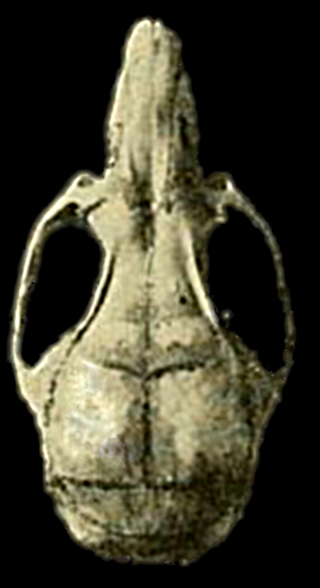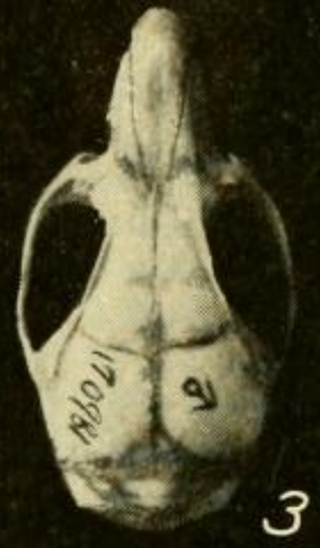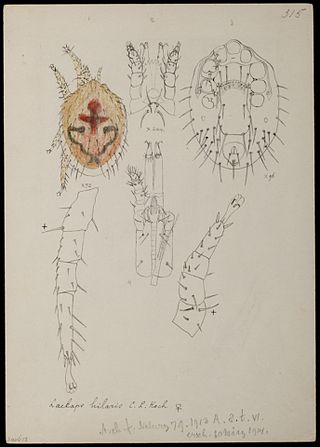
Oryzomys couesi, also known as Coues's rice rat, is a semiaquatic rodent in the family Cricetidae occurring from southernmost Texas through Mexico and Central America into northwestern Colombia. It is usually found in wet habitats, such as marshes, but also lives in drier forests and shrublands. Weighing about 43 to 82 g, O. couesi is a medium-sized to large rat. The coarse fur is buff to reddish above and white to buff below. The hindfeet show some specializations for life in the water, such as reduced ungual tufts of hair around the digits. It has 56 chromosomes. There is much geographic variation in size, proportions, color, and skull features. Oryzomys couesi is active during the night and builds nests of vegetation that are suspended among reeds about 1 m (3.3 ft) above the ground. It is an excellent swimmer and dives well, but can also climb in vegetation. An omnivore, it eats both plant and animal food, including seeds and insects. It breeds throughout the year; females give birth to about four young after a pregnancy of 21 to 28 days. The species may be infected by several different parasites and by two hantaviruses.

Oryzomys is a genus of semiaquatic rodents in the tribe Oryzomyini living in southern North America and far northern South America. It includes eight species, two of which—the marsh rice rat (O. palustris) of the United States and O. couesi of Mexico and Central America—are widespread; the six others have more restricted distributions. The species have had eventful taxonomic histories, and most species were at one time included in the marsh rice rat; additional species may be recognized in the future. The name Oryzomys was established in 1857 by Spencer Fullerton Baird for the marsh rice rat and was soon applied to over a hundred species of American rodents. Subsequently, the genus gradually became more narrowly defined until its current contents were established in 2006, when ten new genera were established for species previously placed in Oryzomys.

Lundomys molitor, also known as Lund's amphibious rat or the greater marsh rat, is a semiaquatic rat species from southeastern South America.

Transandinomys bolivaris, also known as the long-whiskered rice rat, is a rodent in the family Cricetidae. It is found in humid forest from northeastern Honduras to western Ecuador, up to 1,800 m (5,900 ft) above sea level. Since it was first described in 1901 from Ecuador, six scientific names have been introduced for it, but their common identity was not documented until 1998 and the species has long been known under the name Oryzomys bombycinus, described from Panama in 1912. The name Oryzomys bolivaris was used before it was moved to the new genus Transandinomys with Transandinomys talamancae in 2006.

Oryzomys gorgasi, also known as Gorgas's oryzomys or Gorgas's rice rat, is a rodent in the genus Oryzomys of family Cricetidae. First recorded in 1967, it is known from only a few localities, including a freshwater swamp in the lowlands of northwestern Colombia and a mangrove islet in northwestern Venezuela. It reportedly formerly occurred on the island of Curaçao off northwestern Venezuela; this extinct population has been described as a separate species, Oryzomys curasoae, but does not differ morphologically from mainland populations.

The marsh rice rat is a semiaquatic North American rodent in the family Cricetidae. It usually occurs in wetland habitats, such as swamps and salt marshes. It is found mostly in the eastern and southern United States, from New Jersey and Kansas south to Florida and northeasternmost Tamaulipas, Mexico; its range previously extended further west and north, where it may have been a commensal in corn-cultivating communities. Weighing about 40 to 80 g, the marsh rice rat is a medium-sized rodent that resembles the common black and brown rat. The upperparts are generally gray-brown, but are reddish in many Florida populations. The feet show several specializations for life in the water. The skull is large and flattened, and is short at the front.

Transandinomys talamancae is a rodent in the family Cricetidae that occurs from Costa Rica to southwestern Ecuador and northern Venezuela. Its habitat consists of lowland forests up to 1,500 m (5,000 ft) above sea level. With a body mass of 38 to 74 g, it is a medium-sized rice rat. The fur is soft and is reddish to brownish on the upperparts and white to buff on the underparts. The tail is dark brown above and lighter below and the ears and feet are long. The vibrissae (whiskers) are very long. In the skull, the rostrum is long and the braincase is low. The number of chromosomes varies from 34 to 54.
Gigantolaelaps is a genus of mites in the family Laelapidae. It is found in the fur of cricetid rodents, most often from the tribe Oryzomyini, from South America north to the southern United States. They are large (>1 mm) and darkly colored and have a complex life cycle.
Gigantolaelaps mattogrossensis is a mite from the Americas. It has been found on the marsh rice rat, hispid cotton rat, black rat, brown rat, and white-footed mouse in the United States. In Venezuela, it has been recorded from Holochilus brasiliensis, Sigmodon hirsutus, and Marmosa robinsoni. In Argentina, it has been found on Scapteromys aquaticus, Oligoryzomys flavescens, and Holochilus brasiliensis. The North American form was first described as a separate species, Gigantolaelaps cricetidarum, and is still occasionally considered as such.
Androlaelaps fahrenholzi is a species of mite in the genus Androlaelaps of the family Laelapidae. It occurs throughout the contiguous United States, where it has been recorded on the following mammals:
Eutrombicula batatas is a species of chigger.

Haemogamasus is a genus of mites in the family Haemogamasidae. In North America, they mostly infect rodents, in addition to other small mammals such as shrews, talpids, and Virginia opossums.
Listrophorus is a genus of parasitic mites in the family Listrophoridae. North American species with their hosts include:

Listrophoridae is a family of mites in the suborder Psoroptidia of the order Sarcoptiformes. The family contains small, long mites specialized for grasping the hairs of mammals. North American genera include:
Oryzomysia oryzomys is a parasitic mite in the genus Oryzomysia of the family Atopomelidae. It has been found on the marsh rice rat in Georgia. It was formerly known as Chirodiscoides oryzomys in the family Listrophoridae, but was later transferred to the atopomelid genus Oryzomysia.
Prolistrophorus bakeri is a parasitic mite in the genus Prolistrophorus. Together with the Argentine P. hirstianus, it forms the subgenus Beprolistrophorus. P. bakeri has been found on the hispid cotton rat, marsh rice rat, and cotton mouse in Georgia, South Carolina, Texas, and Florida and on Oryzomys couesi in Colima. It was formerly placed in the genus Listrophorus.
Prolistrophorus grassii is a parasitic mite in the genus Prolistrophorus. It was described as Listrophorus grassii in 1954 from the marsh rice rat in Georgia. In 1974, Fain and Hyland placed it in Prolistrophorus and in 1984, Fain and Lukoschus redescribed the species on the basis of collections from the marsh rice rat in Georgia, Alabama, and Florida and the southern bog lemming in Indiana, West Virginia, and Iowa.
Radfordia palustris is a species of mite in the subgenus Hesperomyobia of the genus Radfordia. It has been recorded on the marsh rice rat in Florida, Georgia, and South Carolina.

Laelaps is a genus of common parasitic mites in the family Laelapidae. Species, with their hosts, include:








